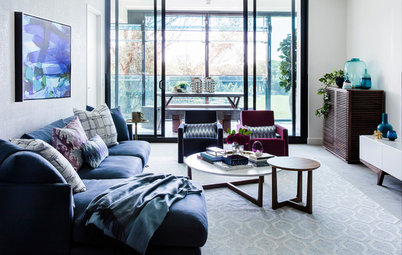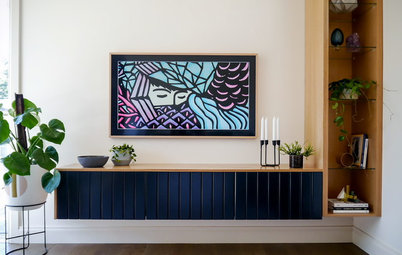Pros Reveal: 10 Features That'll Elevate a Living Room Every Time
Meet the 10 must-have inclusions pros always recommend to clients redesigning a living room
Getting that perfect balance of cosy and functional in a living room can be tricky, which is why homeowners will often turn to a design expert for help. We spoke to five professionals to find out the features and inclusions they put at the top of the list when designing a client’s living area, all guaranteed to take your next living room project from good to great.
Giulianna del Popolo, principal designer at GDP Interior Design, adds:
I’d recommend specifying custom-made upholstery pieces from local makers. Not only does this support local manufacturing, but it’s generally easier to customise pieces to your clients’ needs, you can easily follow the progress of the manufacture, there’s often more flexibility with timing, and you won’t have the hassle (or cost) of relying on overseas shipping.
If you consider the quality and lifespan of custom pieces, they are not necessarily more expensive than imported retail pieces. Superior frames and fill types guarantee a long-life product. If you choose a piece with clean lines and comfortable proportions, it can last your clients for years, with the option to update the look and feel with new upholstery or filling down the track.
I’d recommend specifying custom-made upholstery pieces from local makers. Not only does this support local manufacturing, but it’s generally easier to customise pieces to your clients’ needs, you can easily follow the progress of the manufacture, there’s often more flexibility with timing, and you won’t have the hassle (or cost) of relying on overseas shipping.
If you consider the quality and lifespan of custom pieces, they are not necessarily more expensive than imported retail pieces. Superior frames and fill types guarantee a long-life product. If you choose a piece with clean lines and comfortable proportions, it can last your clients for years, with the option to update the look and feel with new upholstery or filling down the track.
2. Don’t make the TV the focus
Alix Helps, creative director at Alix Helps Interiors, says:
Where possible, look to design the living room so the television is not the main focal point of the room.
Ideally, design custom joinery to house the television or use a dark colour on the wall behind the screen to camouflage it when it’s switched off.
If that’s not possible, consider a television such as The Frame from Samsung, which cunningly disguises the screen as an artwork when it’s not in use.
Learn about Houzz Pro all-in-one business software
Alix Helps, creative director at Alix Helps Interiors, says:
Where possible, look to design the living room so the television is not the main focal point of the room.
Ideally, design custom joinery to house the television or use a dark colour on the wall behind the screen to camouflage it when it’s switched off.
If that’s not possible, consider a television such as The Frame from Samsung, which cunningly disguises the screen as an artwork when it’s not in use.
Learn about Houzz Pro all-in-one business software
3. Pick the right rug
Del Popolo says:
The right floor rug can really make a room and getting the proportion right is part of the success. The rug you specify should appear generous, however leaving some exposed floor around the rug is also important. As a general rule of thumb, choose a size that allows you to have a third or two thirds of the rooms furniture sitting on the rug.
Area rugs not only define and frame the living space, they provide acoustic benefits and add cosiness. Seagrass and sisal rugs look beautiful, but are no fun if your clients are sitting on the floor for games night, so I typically encourage soft-pile carpets.
Del Popolo says:
The right floor rug can really make a room and getting the proportion right is part of the success. The rug you specify should appear generous, however leaving some exposed floor around the rug is also important. As a general rule of thumb, choose a size that allows you to have a third or two thirds of the rooms furniture sitting on the rug.
Area rugs not only define and frame the living space, they provide acoustic benefits and add cosiness. Seagrass and sisal rugs look beautiful, but are no fun if your clients are sitting on the floor for games night, so I typically encourage soft-pile carpets.
4. Ensure plenty of natural light
Alishia Minett Johnson, design director at Minett Studio Architects + Interiors, says:
Orienting the living room towards the north is ideal so you can capture the light, while adding skylights and highlight windows gives you some flexibility with furniture placement.
Capturing different light conditions, such as morning sun and the evening sunset, framing a garden view, or including window seats will all help make a home’s interior more inviting and comfortable.
Alishia Minett Johnson, design director at Minett Studio Architects + Interiors, says:
Orienting the living room towards the north is ideal so you can capture the light, while adding skylights and highlight windows gives you some flexibility with furniture placement.
Capturing different light conditions, such as morning sun and the evening sunset, framing a garden view, or including window seats will all help make a home’s interior more inviting and comfortable.
5. Have a considered lighting scheme
Julianne Bull, principal designer at The Den Interiors, says:
Good lighting in a living room is essential. Consider how your clients will use their living room to determine the lighting you need. Soft ambient lighting is often preferred of an evening when watching TV. Task lighting, such as a floor lamp, is necessary for reading. And don’t forget to highlight any architectural features or artworks with accent lighting create interest and visual drama.
Learn how to keep feeding projects through when you’re busy
Julianne Bull, principal designer at The Den Interiors, says:
Good lighting in a living room is essential. Consider how your clients will use their living room to determine the lighting you need. Soft ambient lighting is often preferred of an evening when watching TV. Task lighting, such as a floor lamp, is necessary for reading. And don’t forget to highlight any architectural features or artworks with accent lighting create interest and visual drama.
Learn how to keep feeding projects through when you’re busy
Helps adds:
Planning ahead for lighting allows you to create different moods in a living space. Aim for a minimum of three different light sources. Include a mix of overhead lighting and an assortment of lamps, both floor and table lamps, to provide options to change the lighting for different moods. This may require running power to a recessed powerpoint in the floor to allow for a reading lamp to be positioned next to a favourite chair.
You may also want to use spotlights to illuminate artworks.
Adding individual dimmers to the light sources in the room will give users the ultimate control over lighting levels.
Planning ahead for lighting allows you to create different moods in a living space. Aim for a minimum of three different light sources. Include a mix of overhead lighting and an assortment of lamps, both floor and table lamps, to provide options to change the lighting for different moods. This may require running power to a recessed powerpoint in the floor to allow for a reading lamp to be positioned next to a favourite chair.
You may also want to use spotlights to illuminate artworks.
Adding individual dimmers to the light sources in the room will give users the ultimate control over lighting levels.
6. Include a fireplace
Minett Johnson says:
A fireplace creates a central focal point in a living room and helps ground the furniture arrangement in the space. It also creates a wonderful spot to put seasonal decorations, cards and treasured mementoes.
Clad it in stone or marble and you instantly elevate the space, while adding a luxurious new material.
Minett Johnson says:
A fireplace creates a central focal point in a living room and helps ground the furniture arrangement in the space. It also creates a wonderful spot to put seasonal decorations, cards and treasured mementoes.
Clad it in stone or marble and you instantly elevate the space, while adding a luxurious new material.
7. Don’t forget storage
Felstead says:
I would always discuss my client’s storage needs with them when designing a living room.
Depending on the space available, storage could be in the form of a TV unit, bookshelves, a sideboard, buffet or side tables.
Felstead says:
I would always discuss my client’s storage needs with them when designing a living room.
Depending on the space available, storage could be in the form of a TV unit, bookshelves, a sideboard, buffet or side tables.
8. Consider multi-purpose pieces
Helps says:
Multi-purpose furniture is a great way to provide extra seating when it’s needed. For example, some small ottomans might serve well as side tables six days a week, but make for a handy extra seat when your client is entertaining.
Similarly, a large ottoman provides a great place to rest your feet on movie night, but when topped with a large tray, forms an elegant coffee table, that can be styled with a few design books, a small vase of flowers and, importantly, a large glass of wine.
Helps says:
Multi-purpose furniture is a great way to provide extra seating when it’s needed. For example, some small ottomans might serve well as side tables six days a week, but make for a handy extra seat when your client is entertaining.
Similarly, a large ottoman provides a great place to rest your feet on movie night, but when topped with a large tray, forms an elegant coffee table, that can be styled with a few design books, a small vase of flowers and, importantly, a large glass of wine.
9. Add layers
Felstead says:
Accessories and small decor pieces add that extra layer of texture, colour and interest to a living room, finishing it off and personalising the space. This might include lamps, soft furnishings, plants, ornaments, vases and candles.
Felstead says:
Accessories and small decor pieces add that extra layer of texture, colour and interest to a living room, finishing it off and personalising the space. This might include lamps, soft furnishings, plants, ornaments, vases and candles.
10. Bring in characterful touches
Bull says:
When decorating a living room, look to introduce something fun and unexpected to the space. Add a splash of colour with art, an interesting lamp or an unusual chair to bring in that element of fun.
Bull says:
When decorating a living room, look to introduce something fun and unexpected to the space. Add a splash of colour with art, an interesting lamp or an unusual chair to bring in that element of fun.
Your turn
Do you have a living room you designed that you’d like to share? Tell us in the Comments below, like this story, save the images for inspiration, and join the conversation.
More
Want more expert insights from fellow pros? Don’t miss this story: Experts Reveal: 8 Laundry Must-Haves That Come Highly Recommended
Do you have a living room you designed that you’d like to share? Tell us in the Comments below, like this story, save the images for inspiration, and join the conversation.
More
Want more expert insights from fellow pros? Don’t miss this story: Experts Reveal: 8 Laundry Must-Haves That Come Highly Recommended


















Alison Felstead, owner and interior designer at Naibu Design, says:
When designing a living room, I’d recommend you select the sofa first as it is generally the largest piece of furniture in the room. It needs to be proportionate to the space it’s going into, and very comfortable (a comfort test in the showroom is recommended).
I will often choose an easy-to-clean fabric in a neutral colour that’s simple to update with cushions.